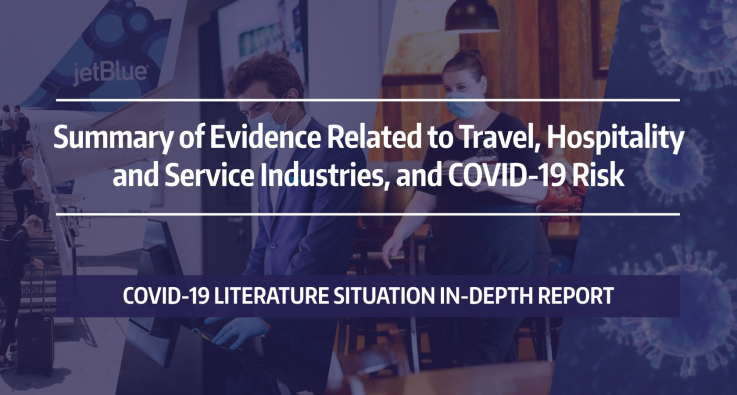Prior to the COVID-19 pandemic, travel was a large part of most individuals’ lives – whether it was for work, leisure, or to visit family. Pre-departure and post-arrival testing and quarantining have become major public health surveillance components of traveling in the last year. Much of the travel industry has been affected by the pandemic, and despite many restrictions in response to the pandemic, essential workers have remained dedicated to their in-person responsibilities while individuals have continued to travel both domestically and internationally. This document is a brief summary of published evidence related to the role of travel in the transmission of SARS-CoV-2 and considerations for traveling during the pandemic. Included are manuscripts published in peer-reviewed journals or on pre-print servers through April 1, 2021. References summarized in this report were drawn from the COVID-19 Literature Report (Lit Rep) team database. References that appeared in the daily Lit Rep are marked with an asterisk*, and the summary is shown in the annotated bibliography below.
EXECUTIVE SUMMARY
- Pre-departure testing for SARS-CoV-2 alone may not be effective at preventing positive individuals from traveling. Addition of post-arrival screening and testing procedures may reduce the risk of travelers spreading SARS-CoV-2 at their destinations. Symptom-based screening alone has been largely ineffective and resource-intensive given its low yield and misses a large proportion of infected travelers due to asymptomatic infections.
- A 10-day quarantine may be sufficient to reduce the risk of transmission. A 7-day quarantine may be feasible when coupled with a negative COVID-19 PCR test on the last day.
- CDC guidance recommends that people who are fully vaccinated with an FDA-authorized vaccine can travel safely within the US. Fully vaccinated travelers do not need to get tested before or after travel unless their destination requires it, and do not need to self-quarantine.
- In-flight transmission of SARS-CoV-2 can occur between passengers and crew members despite facemask use, with closer seating proximity associated with greater infection risk through aerosol and/or respiratory droplet transmission.
- Air travel played a major role in importation of cases internationally early in the pandemic, though domestic US travel is responsible for much of the subsequent spread of SARS-CoV-2 throughout the US.
- Workplace-related outbreaks have been reported across the US since March 2020, with bartenders, waiters, transport conductors and travel stewards at elevated risk of transmission in subsequent waves of the pandemic. In public-facing professions, transmission risk is lower when both employees and clients are wearing facemasks.
FULL REPORT
View the full PDF version of the report, which includes an annotated bibliography. It can also be viewed via the Alliance for Pandemic Preparedness.
